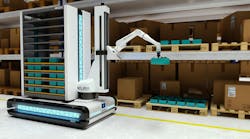Cannabis waste is an urgent issue considering two-thirds of recreational cannabis states are on the coasts or border the Great Lakes. Sana Packaging wants to fight this waste and ocean pollution with its new line of 100% reclaimed ocean plastic packaging. And they're not just removing plastic from the ocean to repurpose it, but creating products with their end-of-life stage in mind. That means ensuring it’s properly disposed of and doesn’t wind up back in the water.
Kicking off its product line is one of the most ubiquitous cannabis waste products out there: pre-roll tubes.
With their first order alone, Sana removed four tons of plastic from the ocean. We caught up with co-founder, James Eichner, to talk about the green innovation and how it's helping to save the planet.
Q: Why was Sana Packaging started and what were the market factors that made you think it would be a profitable venture?
JE: Ron Basak-Smith and I started as cannabis consumers frustrated with the amount of packaging waste the industry is producing. We met during our MBA program at CU-Boulder and Sana Packaging actually started as a class project for a Sustainable Venturing class. We believe packaging should be regenerative and help heal the environment throughout its lifecycle.
We’re in the midst of a global plastic crisis and it’s ludicrous that some companies think it’s ok to use virgin petroleum resins in 2019—especially for single-use products. Since packaging accounts for 40% of global plastic production, transitioning away from virgin petroleum resins for single-use products is a key step in addressing the global plastic crisis.
As a rapidly growing and emerging industry, cannabis has a unique opportunity to implement sustainability from the ground up and set a positive example for other industries to follow. The industry is still developing its best practices. We also have a responsibility to protect our planet for future generations.
Furthermore, the cannabis industry already generates billions of units of plastic packaging waste per year and cannabis packaging is expected to be a $4.1 billion industry by 2025.
Our goal is to help the cannabis industry adopt sustainable and regenerative packaging solutions by using new and emerging materials like hemp bioplastic and reclaimed ocean plastic. There’s also a willingness to pay for new and emerging materials in the cannabis industry so we have an extremely captive customer base.
As for market factors, we’ve seen a renewed interest in the fight against plastic pollution over the past few years—think of plastic straw bans, National Geographic’s “Planet or Plastic?” campaign, countless cities and countries announcing single-use plastic bans, etc. We need to transition to a circular economic model and the way we think about sustainability, disposable products, and waste recovery is evolving. It’s time to change the narrative.
NED: How is the recycled ocean trash collected and delivered to you? Are there any cost advantages to using this type of plastic as opposed to typical recycled plastic?
JE: We partnered with Oceanworks to launch our line of 100% reclaimed ocean plastic cannabis packaging. Oceanworks is a company based in Los Angeles that aims to accelerate the removal of ocean plastic with the long-term goal of a plastic-free ocean. And the Oceanworks Marketplace was created to connect companies like ours with verified sources of ocean plastic collected around the globe.
In short, Oceanworks partners with collectors and processors around the globe to collect, sort, reclaim, recycle, and reintroduce ocean plastic to the marketplace. The ocean plastic we’re using is HDPE collected in Haiti. The sorting of ocean plastic into pure materials is extremely important since what we’re using is 100% HDPE, which is a plastic number 2, our reclaimed ocean plastic products are easy to recycle and the material has value on the secondary market.
There aren’t cost advantages—in the traditional sense—to using reclaimed ocean plastic in comparison to traditional recycled resins. In fact, it’s more expensive. However, the reason petroleum-based resins are so cheap is that we don’t account for negative externalities.
However, we will pay dearly for these negative externalities in the long run—and we already are, just look at ocean plastic pollution. So the cost advantage of using reclaimed ocean plastic is that we’re creating a financial incentive to remove plastic waste from our oceans.
NED: There’s always news of some new trash continent forming in the Pacific. Your tubes are quite small and wouldn’t likely put a big dent in these. Besides good PR, what is the driving factor for doing this?
JE: Sana Packaging is a mission-driven company and while good PR is certainly nice, it’s not a driving factor in our product development choices. Our planet is suffering and we have a responsibility to address the global plastic crisis, plain and simple.
There are already over 150 million metric tons of plastic polluting our oceans and over 8 million metric tons of new plastic entering our oceans every year. If we don’t change our plastic production and consumption habits, by 2050 there will be more plastic in our oceans than fish, by volume.
With the help of our customers, our first run of reclaimed ocean plastic cannabis packaging removed 8,000 pounds of plastic from our oceans and we’re excited to see how much plastic we can continue to remove from our oceans moving forward.
The goal is to get plastic out of our oceans and reintroduce it to the marketplace and proper waste stream.
The private sector has a unique opportunity to address the global plastic crisis by creating a financial incentive to remove plastic waste from our oceans. And given the amount of plastic already in existence, there’s simply no reason to use virgin petroleum resins.
NED: How can other manufacturers follow suit, and if they do, do you have any idea if that could make an impact on ocean pollution?
JE: Creating a financial incentive to remove plastic waste from our oceans can go a long way toward addressing the global plastic crisis, but it’s certainly not a singular solution. Waste recovery—plastic or otherwise—is an extremely complicated issue. Tackling the global plastic crisis will require collaboration between the public and private sectors, changes in consumer behavior, and the full buy-in of our currently fragmented waste recovery system—i.e. recyclers, composters, and landfills.
NED: What can you tell us about the plant-based hemp packaging? How do you see the new relaxation on industrial hemp production rules affecting U.S. manufacturing overall?
JE: Our flagship product line is made from 100% plant-based hemp plastic. More specifically, it’s a fiber-reinforced biocomposite made from 30% micronized hemp hurd and 70% PLA. Hemp is an ideal feedstock for industrial materials because it requires less water than other industrial crops and none of the pesticides. It also grows faster and produces more fiber and cellulose per acre than other industrial crops.
Hemp also remediates the soil so it’s an ideal rotational crop. In other words, hemp is both a rapidly renewable and regenerative crop that can be used for a wide variety of industrial applications, including bioplastics.
The 2018 Farm Bill is a huge step forward for the domestic hemp industry. That said, the industry still has a long way to go. The overall infrastructure of the domestic hemp industry is lacking, especially when it comes to the equipment required to process hemp into useful materials.
We hope to see this change more rapidly now that hemp is no longer under federal prohibition.
NED: For those not in the cannabis manufacturing industry, what are the key things to know going into the 2020s?
JE: At its core, cannabis is an environmental and social justice movement and there’s no place in this industry for people looking to make a quick buck. Cannabis is rooted in the back to the land movement of the 1970s and the opposition to our government’s war on drugs.
We can’t forget the people and communities that suffered—and continue to suffer—because of unjust laws. Just say no to the war on drugs!
NED: How do you see the growth of the cannabis industry affecting the overall economy of America in the next decade?
JE: We believe cannabis and industrial hemp have the potential to reinvigorate economically stifled agricultural communities across the United States. And of course, the tax revenue generated by the cannabis industry can be put towards all sorts of worthy projects. Just look at Colorado—the state has used cannabis tax revenue to do everything from renovating public schools to feeding the homeless.













